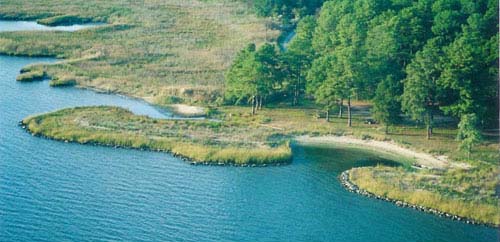
MDE’s regulations require that a proposed Critical Area Buffer Management Plan (BMP) and a Critical Area Buffer Notification Form (BNF) be submitted as part of the Joint Permit Application (JPA) for shore erosion control projects. This enhances coordination between MDE, the Critical Area Commission, and local governments.
The Commission has developed BMP forms for each type of specific shore erosion control project (Living Shoreline, Revetment, Bulkhead Replacement, Offshore Work). The BMPs and the BNF can be found by clicking on the specific shore erosion control project below. Ideally, an applicant may submit the completed forms under the JPA process and to the local jurisdiction to fulfill the Buffer Management Plan requirements under COMAR 27.01.09. However, many local governments use customized forms for BMPs associated with shore erosion control. Please contact your local permit office to determine if any additional forms or information is required.
Living Shoreline (Type 1)
Click image for more information
For a shore erosion control project involving a living shoreline where the existing Buffer is lawn or lawn interspersed with trees, and the proposed Buffer disturbance extends less than 15 feet landward of mean high water.
- BMP and BNF accessed here
- Example Living Shoreline Type 1 BMP
here
Living Shoreline (Type 2)
Click image for more information
For a shore erosion control project involving a living shoreline where the existing Buffer is densely vegetated/forested, or the proposed Buffer disturbance extends more than 15 feet landward of mean high water.
- BMP and BNF accessed here
- Example Living Shoreline Type 2 BMP
here
Revetment
Click image for more information
For a shore erosion control project involving a revetment. Note that mitigation will depend on the existing conditions of the Buffer at the site and the proposed limit of disturbance.
- Type 1 – Existing Buffer is lawn or lawn interspersed with trees and permanent buffer disturbance extends less than 10 feet landward.
- Type 2 – Existing Buffer is densely vegetation/forested or permanent buffer disturbance extends more than 10 feet landward.
- BMP and BNF accessed here
- Example Revetment BMP here
Bulkhead Replacement Only
Click image for more information
For a shore erosion control project that only involves the replacement of an existing bulkhead.
- BMP and BNF accessed here
Offshore Work Only
Click image for more information
For a shore erosion project that is accessed via the water and does not result in any impacts to the land (e.g., clearing, grading, stockpiling, etc.). This may include breakwaters, marsh edging, stone in front of an existing bulkhead, etc.
- BMP and BNF accessed here